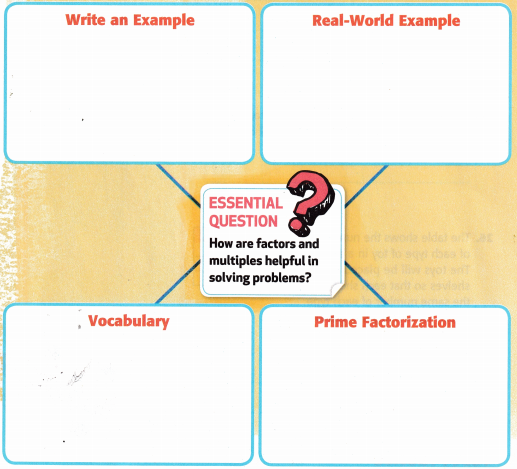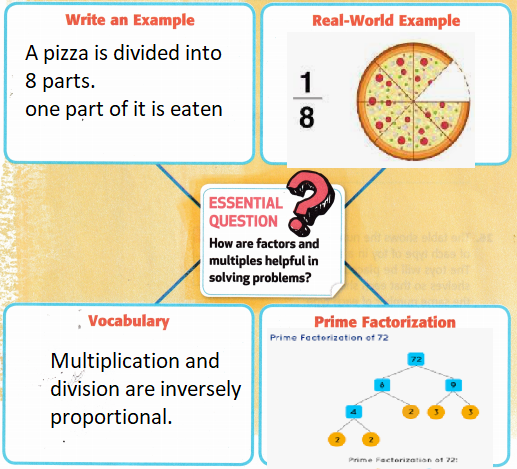All the solutions provided in McGraw Hill My Math Grade 5 Answer Key PDF Chapter 8 Review will give you a clear idea of the concepts.
McGraw-Hill My Math Grade 5 Chapter 8 Review Answer Key
Vocabulary Check
Use the word bank below to complete each sentence.
common factor
common multiple
denominator
equivalent fractions
fraction
greatest common factor (GCF)
least common multiple (LCM)
least common denominator (LCD)
multiple
numerator
simplest form
Question 1.
The _____ is the least multiple, other than 0, common to sets of multiples.
Answer:
least common multiple (LCM)
Explanation:
The least common multiple (LCM) is the least multiple, other than 0, common to sets of multiples.
Question 2.
Fractions that name the same number are _____
Answer:
equivalent fractions.
Explanation:
Fractions that name the same number are equivalent fractions.
Question 3.
The top number of a fraction is called the _____
Answer:
Numerator
Explanation:
The top number of a fraction is called the Numerator
Question 4.
When the numerator and the denominator have no common factor greater than 1, the fraction is written in ____
Answer:
simplest form
Explanation:
When the numerator and the denominator have no common factor greater than 1, the fraction is written in simplest form.
Question 5.
The bottom number of a fraction is called the ____
Answer:
Denominator
Explanation:
The bottom number of a fraction is called the Denominator
Question 6.
A whole number that is a factor of two or more numbers is called a(n) _____
Answer:
common factor
Explanation:
A whole number that is a factor of two or more numbers is called a(n) common factor
Question 7.
The greatest of the common factors of two or more numbers is the ____ of the numbers.
Answer:
greatest common factor
Explanation:
The greatest of the common factors of two or more numbers is the greatest common factor of the numbers.
Question 8.
The ____ is the least common multiple of the denominators of the fractions.
Answer:
Least Common Denominator (LCD)
Explanation:
The Least Common Denominator (LCD) is the least common multiple of the denominators of the fractions.
Concept Check
Find the GCF of each set of numbers.
Question 9.
11, 44 ___
Answer:
11
Explanation:
The factors of 11 = 1 and 11
The factors of 44 = 1, 2, 4, 11, 22, 44
The common factors are 1, 11
So, the GCF of 11 and 44 is 11
Question 10.
12, 21, 30 ____
Answer:
Explanation:
The factors of 12 = 1, 2, 3, 4, 6 and 12
The factors of 21 = 1, 3, 7 and 21
The factors of 30 = 1, 2, 3, 5, 6, 10, 15 and 30
The common factors are 1, 3
So, the GCF of 12, 21, 30 is 3
Write each fraction In simplest form. If the fraction Is already in simplest form, write simplified.
Question 11.
\(\frac{3}{36}\) _____
Answer:
\(\frac{1}{12}\)
Explanation:
The GCF of 3 and 36 is 3
Divide the numerator and denominator by the common factor 3
In simplest form \(\frac{3}{36}\) = \(\frac{1}{12}\)
Question 12.
\(\frac{25}{30}\) _____
Answer:
\(\frac{5}{6}\)
Explanation:
The GCF of 25 and 30 is 5
Divide the numerator and denominator by the common factor 5
In simplest form \(\frac{25}{30}\) = \(\frac{5}{6}\)
Find the LCM of each set of numbers.
Question 13.
4, 9 ___
Answer:
36
Explanation:
4 : 4, 8, 12, 26, 20, 24, 28, 32, 36 and 40
9 : 9, 18, 27, 36, 45, 54, 63, 72, 81, 90
So, the LCM of 4 and 9 is 36
Question 14.
5, 7, 10 ____
Answer:
70
Explanation:
5 : 5, 10, 15, 20, 25, 30, 35, 40, 45, 50, 55, 60, 65, 70
7 : 7 ,14 ,21 ,28 ,35 ,42 ,49 ,56 ,63 ,70
10 : 10, 20, 30, 40, 50, 60,70
So, the LCM of 5, 7, 10 is 70
Compare each pair of fractions using models or the LCD. Use the symbols <, >, or =.
Question 15.
\(\frac{2}{5}\) ![]() \(\frac{3}{10}\)
\(\frac{3}{10}\)
Answer:
5 : 5, 10, 15, 20, 25, 30, 35, 40, 45, 50
10 : 10, 20, 30, 40, 50, 60,70
So, the LCM of 5, 10 is 10
Explanation:
Find equivalent fractions with a denominator of 10
\(\frac{4}{10}\) and \(\frac{3}{10}\)
Compare numerators 4 is greater than 3 so,
\(\frac{2}{5}\) ![]() \(\frac{3}{10}\)
\(\frac{3}{10}\)
Question 16.
\(\frac{1}{5}\) ![]() \(\frac{1}{4}\)
\(\frac{1}{4}\)
Answer:
5 : 5, 10, 15, 20, 25, 30, 35, 40, 45, 50
4 : 4, 8, 12, 26, 20, 24, 28, 32, 36
So, the LCM of 5, 4 is 20
Explanation:
Find equivalent fractions with a denominator of 20
\(\frac{4}{20}\) and \(\frac{5}{20}\)
Compare numerators 4 is less than 5 so,
\(\frac{1}{5}\) ![]() \(\frac{1}{4}\)
\(\frac{1}{4}\)
Question 17.
\(\frac{3}{4}\) ![]() \(\frac{18}{24}\)
\(\frac{18}{24}\)
Answer:
4 : 4, 8, 12, 26, 20, 24, 28, 32, 36
24 : 24, 48, 72, 96, 120
So, the LCM of 4 , 24 is 24
Explanation:
Find equivalent fractions with a denominator of 24
\(\frac{18}{24}\) and \(\frac{18}{24}\)
Compare numerators 18 is equal to 18 so,
\(\frac{3}{4}\) ![]() \(\frac{18}{24}\)
\(\frac{18}{24}\)
Write each fraction as a decimal.
Question 18.
\(\frac{3}{10}\) = _____
Answer:
0.3
Explanation:
Since it is the fraction with denominator 10 we can make it to decimal.
\(\frac{3}{10}\) = three tenths or 0.3
Question 19.
\(\frac{19}{50}\) = _____
Answer:
0.38
\(\frac{19}{50}\) =
Explanation:
Find equivalent fractions with a denominator of 100.
Since 50 × 2 = 100, multiply 19 × 2 to obtain 38.
Write the fraction with a denominator of 100 as a decimal.
So, \(\frac{19}{50}\) = \(\frac{38}{100}\) means thirty eight hundredths, or 0.38.
Read the decimal as thirty eight hundredths
Question 20.
\(\frac{5}{10}\) = _____
Answer:
\(\frac{5}{10}\) = 0.5
Explanation:
Since it is the fraction with denominator 10 we can make it to decimal.
\(\frac{5}{10}\) = five tenths or 0.5
Question 21.
\(\frac{1}{5}\) = _____
Answer:
\(\frac{1}{5}\) = 0.2
Explanation:
Find equivalent fractions with a denominator of 10.
Since 5 × 2 = 10, multiply 1 × 2 to obtain 2.
Write the fraction with a denominator of 10 as a decimal.
So, \(\frac{1}{5}\) = \(\frac{2}{10}\) means two tenths, or 0.2.
Read the decimal as two tenths
Question 22.
\(\frac{14}{25}\) = _____
Answer:
\(\frac{14}{25}\) = 0.56
Explanation:
Find equivalent fractions with a denominator of 100.
Since 25× 4 = 100, multiply 14 × 4 to obtain 56.
Write the fraction with a denominator of 100 as a decimal.
So, \(\frac{14}{25}\) = \(\frac{56}{100}\) means fifty six hundredths, or 0.56.
Read the decimal as fifty six hundredths
Question 23.
\(\frac{3}{25}\) = _____
Answer:
\(\frac{3}{25}\) = 0.12
Explanation:
Find equivalent fractions with a denominator of 100.
Since 25× 4 = 100, multiply 3× 4 to obtain 12.
Write the fraction with a denominator of 100 as a decimal.
So, \(\frac{3}{25}\) = \(\frac{12}{100}\) means twelve hundredths, or 0.12.
Read the decimal as twelve hundredths
Problem Solving
Question 24.
Three bags of packing peanuts are used to fill 2 boxes. How many bags of packing peanuts does each box use? Between which two whole numbers does the answer lie?
Answer:
1.5
Explanation:
If you need to know the number of bags per box, or bags/box
then you know to divide the number of bags by number of boxes:
3 bags/(2 boxes) = 1.5 bags/box
1.5 bags of packing peanuts each box use
so the answer lies between 1 and 2
Question 25.
A van has room for 6 students and 2 teachers. How many vans are needed for a total of 48 students and 16 teachers?
Answer:
8
Explanation:
A van has room for 6 students and 2 teachers.
Total number of students = 48, to find the number of vans needed we take the quotient between the number of students and the number of students that fit on each van,
\(\frac{48}{6}\) = 8
And there are 16 teachers,
\(\frac{16}{2}\) = 8
So we need 8 vans for 48 students and 16 teachers.
Question 26.
The table shows the number of each type of toy in a store. The toys will be placed on shelves so that each shelf has the same number of each type of toy. How many shelves are needed for each type of toy so that it has the greatest number of toys?
Answer:
15 shelves
Explanation:
45 : 1, 3, 5, 9, 15, 45.
105: 1, 3, 5, 7, 15, 21, 35 ,105.
75: 1, 3, 5, 15, 25 ,75.
The common factor of 45, 105, 75 is 15
Therefore , we will need 15 shelves.
On each shelf there will be \(\frac{45}{15}\) = 3dolls , \(\frac{105}{15}\) = 7 footballs, \(\frac{75}{15}\) = 5 small cars.
Test Practice
Question 27.
In a typical symphony orchestra, 16 out of every 100 musicians are violinists. What fraction of the orchestra are violinists?
A. \(\frac{2}{25}\)
B. \(\frac{4}{25}\)
C. \(\frac{1}{5}\)
D. \(\frac{8}{25}\)
Answer:
B
Explanation:
The GCF of 16 and 100 is 4
Divide the numerator and denominator by the common factor 4
In simplest form \(\frac{16}{100}\) = \(\frac{4}{25}\)
\(\frac{4}{25}\) fraction of the orchestra are violinists
Reflect
Use what you learned about fractions and decimals to complete the graphic organizer.

Now reflect on the ESSENTIAL QUESTION? Write your answer below.
________________________________
________________________________
Answer:
